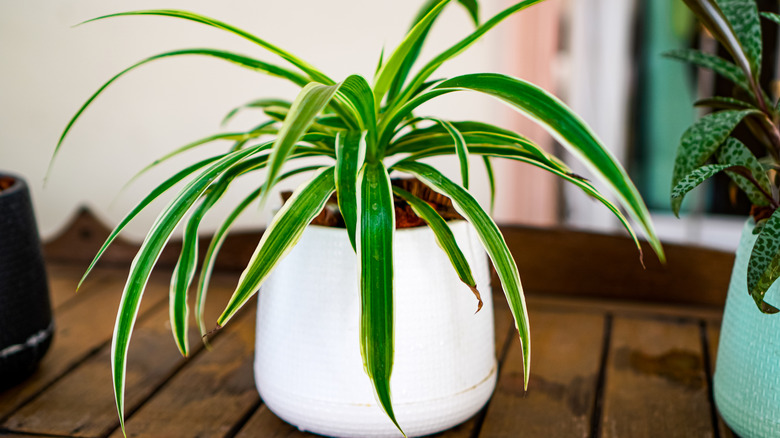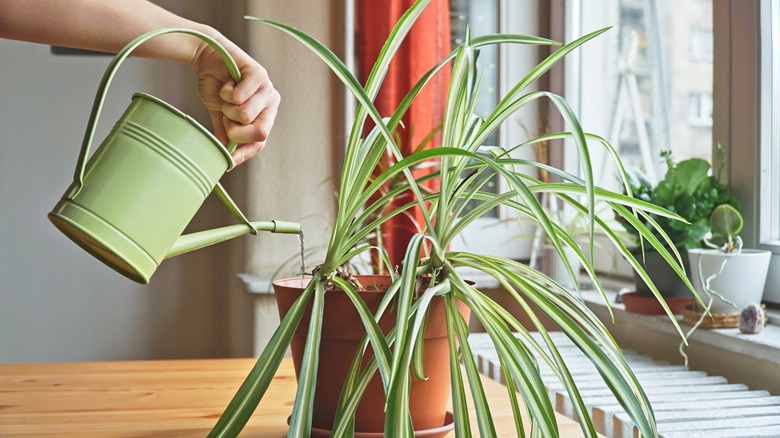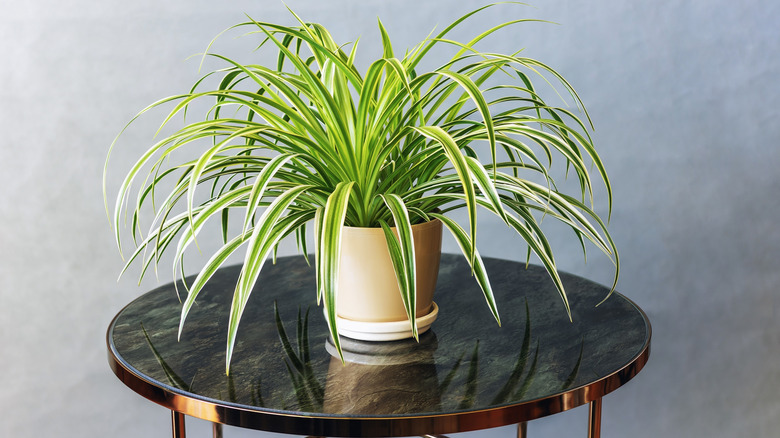Budget-Friendly Tips To Make A Spider Plant Bushier And Healthier Than Before
There are several reasons why spider plants can make the perfect houseplant. Their long, multi-toned green leaves add some visual intrigue to a space, whether hanging by a window or sitting in a pot on a desk or countertop. These plants are also pretty easy to care for. You may even see them frequently recommended for those who have trouble keeping other plants alive. However, despite being relatively easy to take care of, you may be noticing that your plant doesn't look very full. If the leaves aren't bushy, it can make the plant look sparse or even unhealthy.
If your spider plant isn't as bushy as you would like, there's no reason to fret. With some TLC, good gardening practices, or even a bit of propagation, you can transform the look of these resilient houseplants. And, even better, you won't have to spend a fortune doing so. One of the main reasons your spider plant may not have a very bushy and full appearance relates back to two of the key components that all plants need to thrive: water and light. Spider plants may be able to survive when these conditions are less than ideal. However, you shouldn't expect them to thrive and have a full, bushy, and healthy appearance if you're not providing them with optimal growing conditions. Fortunately, sunlight is free, and the amount of water your plant will need shouldn't have next to no impact on your utility bills.
Make sure that you're providing your spider plant what it needs to be healthy
It's unreasonable to expect your spider plant to look bushy if it's only just surviving. Those lush, green, and full leaves that you want to see will only be possible if the plant is healthy — not only just hanging on. So, you'll want to fine-tune your care schedule and go back to the basics of remembering how to care for and grow a spider plant. Doing so can help move the plants from just being alive to thriving.
As with other plants, proper watering is key. If your spider plant looks overly thin and leggy, a lack of enough water could be holding it back from filling out to give that bushy look that you're after. Spider plants typically need to be watered about once per week. However, always check to make sure that the soil is dry. Otherwise, you could overwater the plant, which also won't help it fill out. Spider plants also need light in order to thrive. If you're growing your plant in a darker corner of an office or bedroom, consider repositioning it to help it get more sunlight. You should aim for a location that will provide between four and six hours of indirect light each day.
Spider plants have fewer pest problems than some other plants. However, if there is a pest problem, it can certainly make the leaves look less healthy and bushy. Consider using a common kitchen ingredient that spider plants love and soil pests hate: coffee grounds. The strong scent of the grounds can deter pests from making themselves at home.
Let baby spiderettes grow with the parent plant for a bushier look
Once you've made sure that you're giving your spider plant everything it needs to be healthy, you should start to notice a positive change in its appearance. Over time, as these needs continue to be met, the plant should start looking fuller. However, it may still not be as full and bushy as you'd like. Fortunately, there is one trick you can try.
Many spider plants produce many babies (spiderettes). You may be in the habit of propagating these babies and planting them in a new pot to add to a new location in your home or to give to a friend or family member. However, did you know that you can also use these babies to give the parent plant a bushier appearance? Plant a few alongside the mother. As they grow, it will look like you have one big, bushy, and healthy spider plant.
Before you just start planting the little spiderettes, there are a few things to keep in mind. If you want them to have the greatest shot at surviving and thriving, you should plant them in the soil while they are still connected to the mother. Only disconnect them from the parent plant after they have taken root and are looking healthy. While these new plants are starting to grow, you'll want to increase your watering routine slightly.


